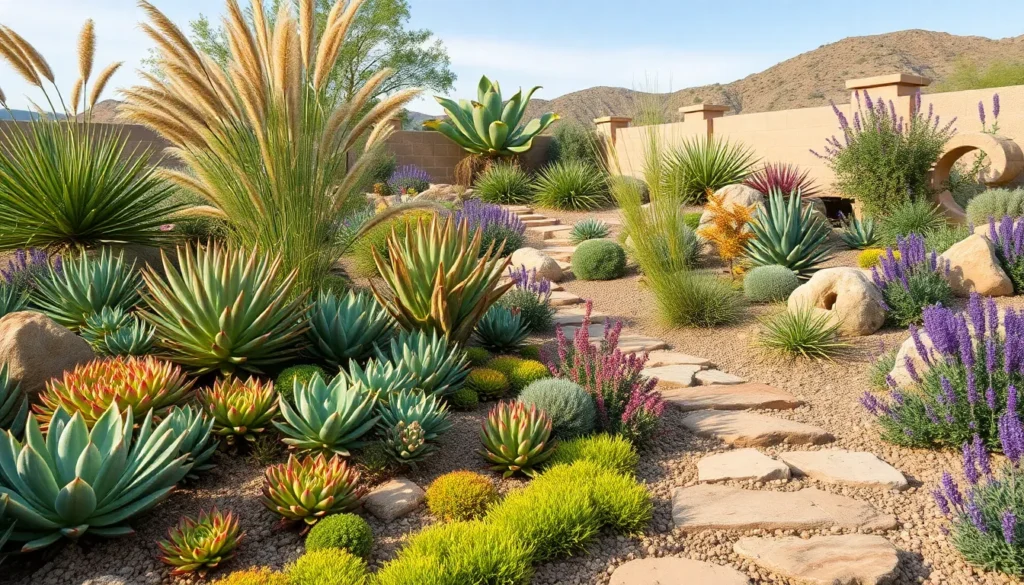We’ve all watched our water bills skyrocket during summer months while desperately trying to keep our gardens alive. Dry gardening isn’t just a trending solution – it’s a game-changing approach that’ll transform your outdoor space into a stunning low-maintenance paradise.
Drought-resistant landscaping offers incredible benefits beyond water conservation. You’ll spend less time with the hose and more time enjoying your beautiful yard. These gardens thrive in challenging conditions while delivering year-round visual appeal that neighbors can’t help but admire.
Whether you’re dealing with sandy soil, facing water restrictions, or simply want a gorgeous garden that doesn’t demand constant attention, we’ll show you how to create an impressive dry garden that flourishes without very costly or your back.
Create a Stunning Succulent Paradise
Succulents transform any dry garden into a breathtaking industry that requires minimal water while delivering maximum visual impact. We’ve discovered that these remarkable plants offer endless possibilities for creating dramatic focal points and textured displays.
Choose Low-Water Succulents for Maximum Impact
Echeveria varieties create perfect rosette formations that catch morning light beautifully. We recommend planting these compact beauties in clusters of 3-5 for stunning ground coverage that spreads naturally over time.
Jade plants develop into sculptural specimens that anchor garden beds with their thick, glossy leaves. These hardy succulents can grow up to 3 feet tall and require watering only once every 2-3 weeks during growing season.
Hens and chicks multiply rapidly to form dense mats of geometric patterns across rocky slopes. We’ve seen single plantings expand to cover 4-square-foot areas within two growing seasons.
Barrel cacti provide striking vertical elements that demand attention in any succulent arrangement. These slow-growing champions store water for months and produce vibrant yellow or red blooms in late spring.
Design with Architectural Plants Like Agave and Aloe
Century plants create dramatic focal points with their sword-like leaves spanning up to 6 feet across. We position these giants as cornerstone plants that define the entire garden’s character and scale.
Aloe vera offers both beauty and functionality with its healing properties and architectural form. These versatile plants thrive in containers or ground plantings and produce stunning orange flower spikes annually.
Blue agave brings striking blue-gray coloration that contrasts beautifully with warm-toned sedums. We space these specimens at least 8 feet apart to accommodate their mature 4-foot spread.
Octopus agave provides unique twisted leaves that create sculptural interest throughout all seasons. These conversation starters reach 3 feet in height and complement modern industry designs perfectly.
Incorporate Colorful Sedums for Year-Round Interest
Autumn Joy sedum transitions from green to deep burgundy as temperatures drop in fall. We plant these perennials in masses of 12-15 plants to create sweeping color displays that last through winter.
Dragon’s Blood sedum carpets the ground with deep red foliage that intensifies in full sun. This low-growing variety spreads 18 inches wide and requires division every 3-4 years to maintain vigor.
Coral Carpet sedum produces bright coral-pink flowers that bloom for 6-8 weeks in summer. We use this variety to edge pathways and fill gaps between larger architectural succulents.
Golden sedum adds cheerful yellow-green foliage that brightens shaded areas under taller plants. These compact growers reach only 4 inches tall but spread 12 inches wide to create natural groundcover.
Transform Your Space with Drought-Tolerant Ornamental Grasses
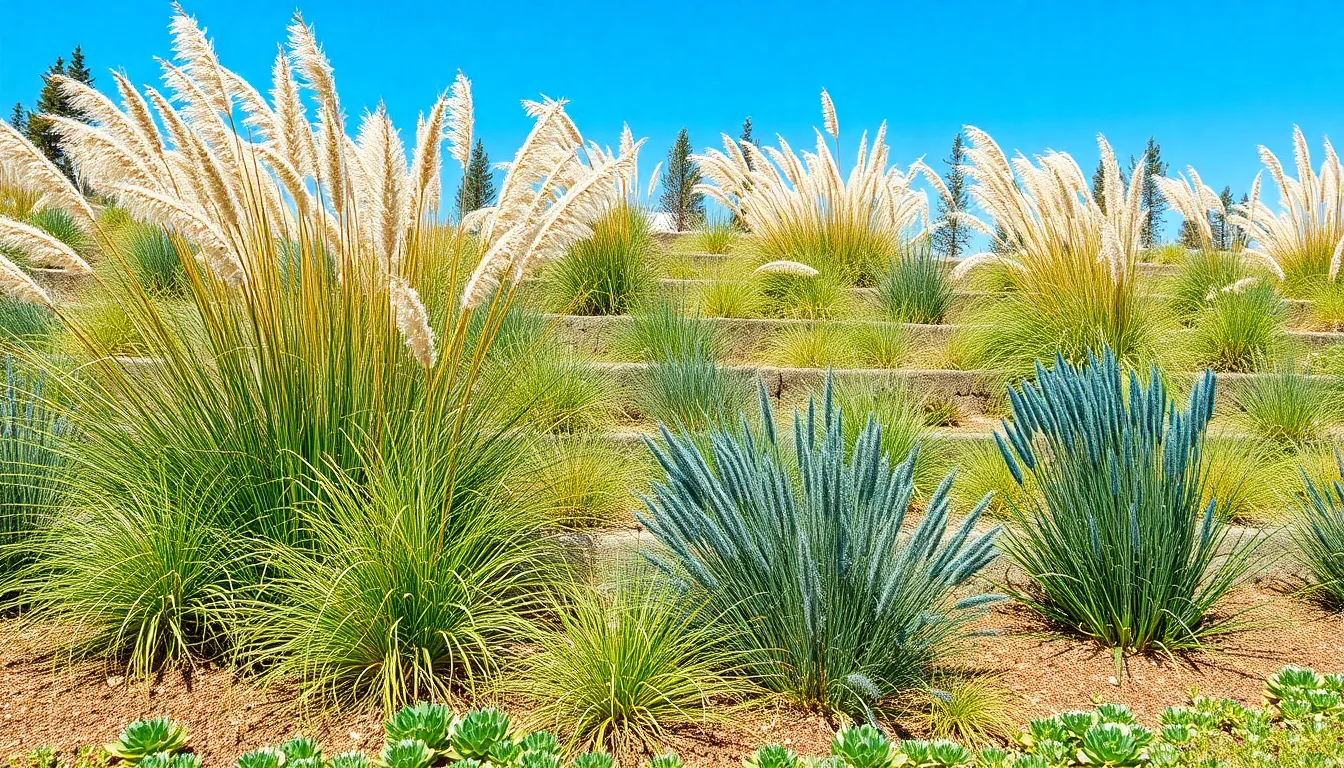
Building on our succulent foundation creates an excellent base for incorporating ornamental grasses into your dry garden design. These resilient plants offer exceptional water efficiency while adding texture, movement, and seasonal interest to complement your existing drought-tolerant industry.
Select Native Grasses for Regional Authenticity
Native ornamental grasses provide the most sustainable and authentic foundation for your dry garden transformation. Regional varieties like blue grama (Bouteloua gracilis) and feather reed grass (Calamagrostis x acutiflora) naturally adapt to local climate conditions and soil types, requiring minimal intervention once established.
Benefits of choosing native species extend beyond water conservation to include enhanced biodiversity support and reduced maintenance demands. Local grasses thrive without fertilizers, resist common pests, and contribute to the natural network by providing habitat for beneficial insects and birds.
Cost effectiveness becomes apparent when you select varieties that naturally flourish in your area’s precipitation patterns. Native grasses eliminate the need for supplemental irrigation systems while establishing deep root systems that improve soil structure and prevent erosion.
Combine Different Textures and Heights for Visual Appeal
Layering grasses of varying heights creates ever-changing visual interest throughout your dry garden space. Tall backdrop varieties like maiden grass (Miscanthus) establish structure and privacy, while shorter ground-level options such as fescue (Festuca) and blue oat grass (Helictotrichon sempervirens) provide textural contrast and fill gaps between larger plants.
Movement and seasonal changes become key design elements when you incorporate grasses with different growth patterns. Fine-textured varieties sway gently in breezes, adding kinetic energy that contrasts beautifully with the static forms of succulents and architectural plants.
Scale relationships work best when you arrange taller specimens toward the back of planting areas and shorter varieties in front. This tiered approach maximizes visual impact while ensuring each plant receives adequate sunlight and air circulation.
Use Grasses as Natural Borders and Dividers
Ornamental grasses serve as effective living boundaries that soften harsh lines while defining separate garden zones. Varieties like switchgrass (Panicum virgatum) and fountain grass (Pennisetum) create natural screens that filter light while maintaining openness between different areas of your industry.
Pathway definition becomes elegant when you use grasses to frame walkways and transition zones. Their slender forms allow visual connection between spaces while providing subtle separation that guides movement through your garden without creating barriers.
Maintenance advantages over traditional hardscape borders include flexibility for seasonal changes and natural adaptation to your garden’s evolving needs. Living dividers grow and adjust to your industry while requiring only annual cutting back compared to the permanent installation costs of fencing or stone walls.
Design a Mediterranean-Inspired Herb Garden
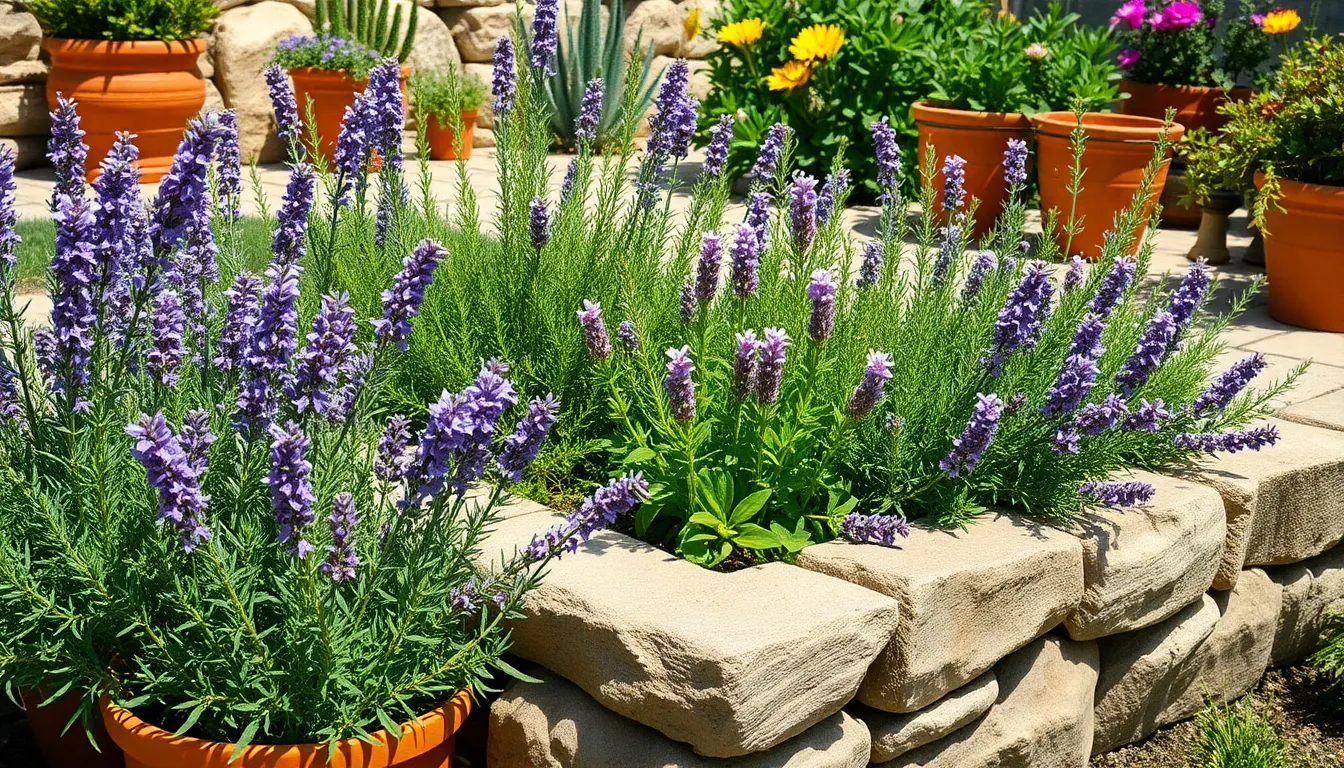
Mediterranean herb gardens bring drought resistant beauty to any dry industry while providing aromatic plants for your kitchen. We’ll explore how to create this water efficient garden style that thrives in hot, dry conditions.
Plant Aromatic Herbs Like Rosemary and Lavender
Rosemary transforms any dry garden with its needle like foliage and pine scented fragrance that releases into the air with every breeze. This classic Mediterranean herb grows exceptionally well in drought conditions and provides year round structure to your garden design. We recommend planting rosemary along pathways where you’ll brush against it regularly to enjoy its aromatic qualities.
Lavender creates stunning purple displays while requiring minimal water once established in your Mediterranean herb garden. The fragrant flowers attract beneficial pollinators like bees and butterflies throughout the growing season. Plant lavender varieties such as English lavender or Spanish lavender in full sun locations where they’ll develop the strongest fragrance and most vibrant blooms.
Create Functional Beauty with Culinary Herbs
Basil adds Mediterranean flavor to your dry garden while thriving in well drained soil conditions with partial sun exposure. We suggest growing varieties like Greek basil or African blue basil that handle heat stress better than traditional sweet basil. These drought tolerant basil types provide continuous harvests for your Mediterranean cooking needs.
Thyme spreads naturally across dry garden spaces while offering versatile culinary applications in Mediterranean dishes. This low growing herb tolerates various soil conditions and requires virtually no supplemental watering once established. Plant creeping thyme between stepping stones or along garden borders where it’ll create fragrant carpets of tiny leaves.
Arrange Herbs in Raised Beds for Better Drainage
Raised beds prevent waterlogged soil that can damage Mediterranean herbs by ensuring proper drainage throughout the growing season. We recommend building beds 8 to 12 inches high using materials like stone, cedar, or composite lumber that complement the Mediterranean aesthetic. Fill beds with well draining soil mixed with gravel or sand to replicate the rocky soils these herbs prefer.
Natural materials enhance the authentic Mediterranean look while providing functional growing spaces for your herb collection. Incorporate terracotta pots, limestone rocks, or decomposed granite pathways around your raised beds to create visual cohesion. Arrange taller herbs like rosemary toward the back of beds with shorter varieties like thyme cascading over the edges for maximum visual impact.
Build Dramatic Rock Gardens and Stone Features
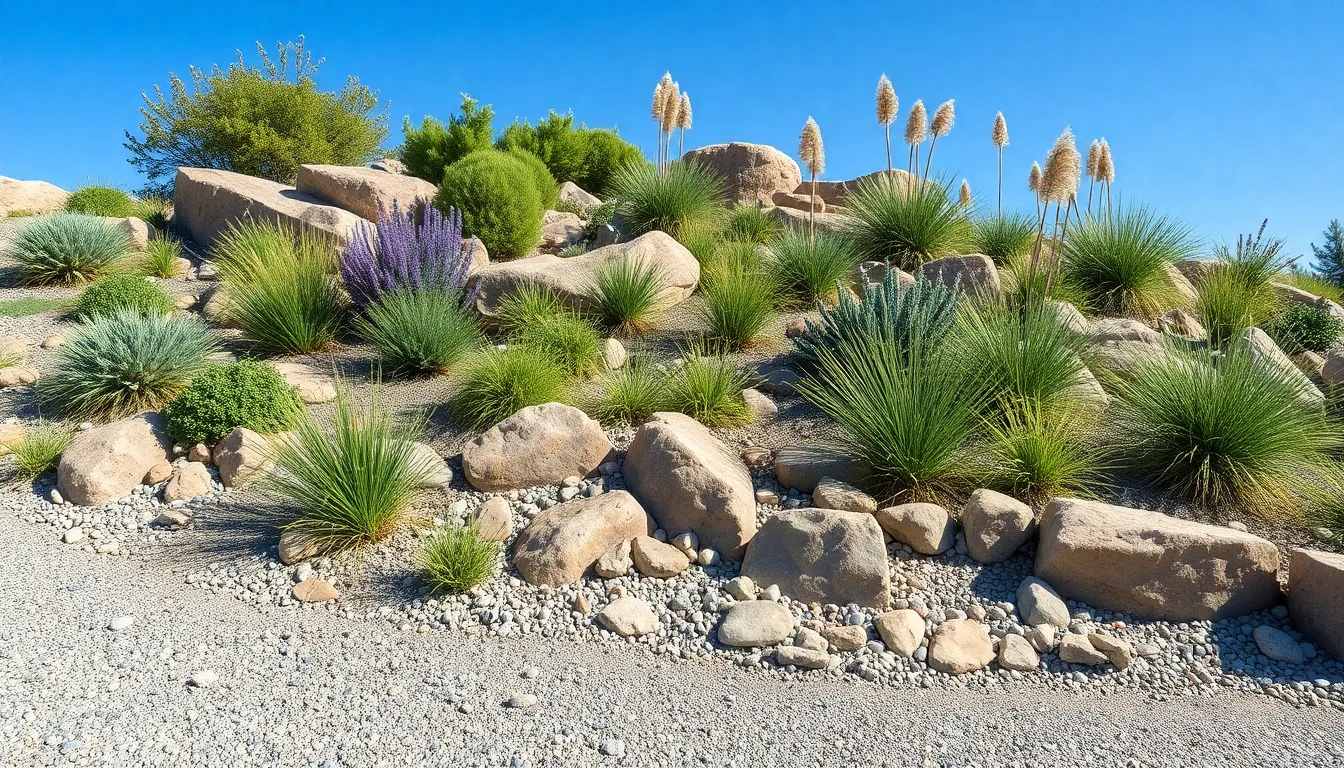
Rock gardens transform flat dry landscapes into captivating outdoor spaces that require minimal water while delivering maximum visual impact. Stone features anchor your drought-resistant design and create natural focal points that complement Mediterranean herbs and ornamental grasses.
Incorporate Natural Stone for Authentic Appeal
Natural stone provides the foundation for creating visually appealing rock gardens that seamlessly blend with your existing dry garden elements. We recommend selecting stones from local quarries to ensure your garden reflects the authentic character of your region while maintaining cost efficiency.
Different types of stone add variety and depth to your garden design, creating natural pathways that connect your succulent displays with herb sections. Limestone pairs beautifully with Mediterranean plants like rosemary and lavender, while sandstone complements ornamental grasses and provides warm earth tones.
Using natural stone as borders creates defined planting areas for your drought-tolerant plants without requiring extensive maintenance. We suggest incorporating larger stones as focal points where your pathways intersect, creating natural gathering spots that enhance the overall garden experience.
Create Elevation Changes with Rocky Slopes
Rocky slopes add dramatic visual interest to your dry garden by creating varied levels that showcase different plant collections at their best advantage. These elevation changes make your garden more captivating while providing natural drainage answers for your water-efficient industry.
Incorporating rocky slopes allows you to display drought-tolerant plants like agave and barrel cacti at eye level, creating stunning vignettes that draw visitors through your garden space. We recommend building slopes at gentle angles to ensure plant stability while maximizing the dramatic effect.
Varied levels work particularly well for showcasing your ornamental grass collections, with tall varieties like feather reed grass planted at the top of slopes and shorter sedums cascading down the rocky surfaces. This layering technique creates natural transitions between different garden zones while maintaining water efficiency.
Use Gravel Mulch to Suppress Weeds and Retain Moisture
Gravel mulch effectively suppresses weeds while reducing competition for water and nutrients among your carefully selected drought-resistant plants. This mulching method works exceptionally well around stone features, creating cohesive design elements that tie your rock garden together.
Moisture retention becomes significantly improved when we apply gravel mulch around herbs like thyme and rosemary, helping these Mediterranean plants thrive in challenging dry conditions. The gravel reflects heat during intense summer months while preventing soil erosion around your rocky slopes.
Weed suppression saves countless hours of maintenance time, allowing your authentic stone features to remain the focal points without unwanted plant competition. We suggest using decomposed granite or pea gravel that complements your natural stone selection, creating unified color schemes throughout your dramatic rock garden design.
Establish Native Plant Communities
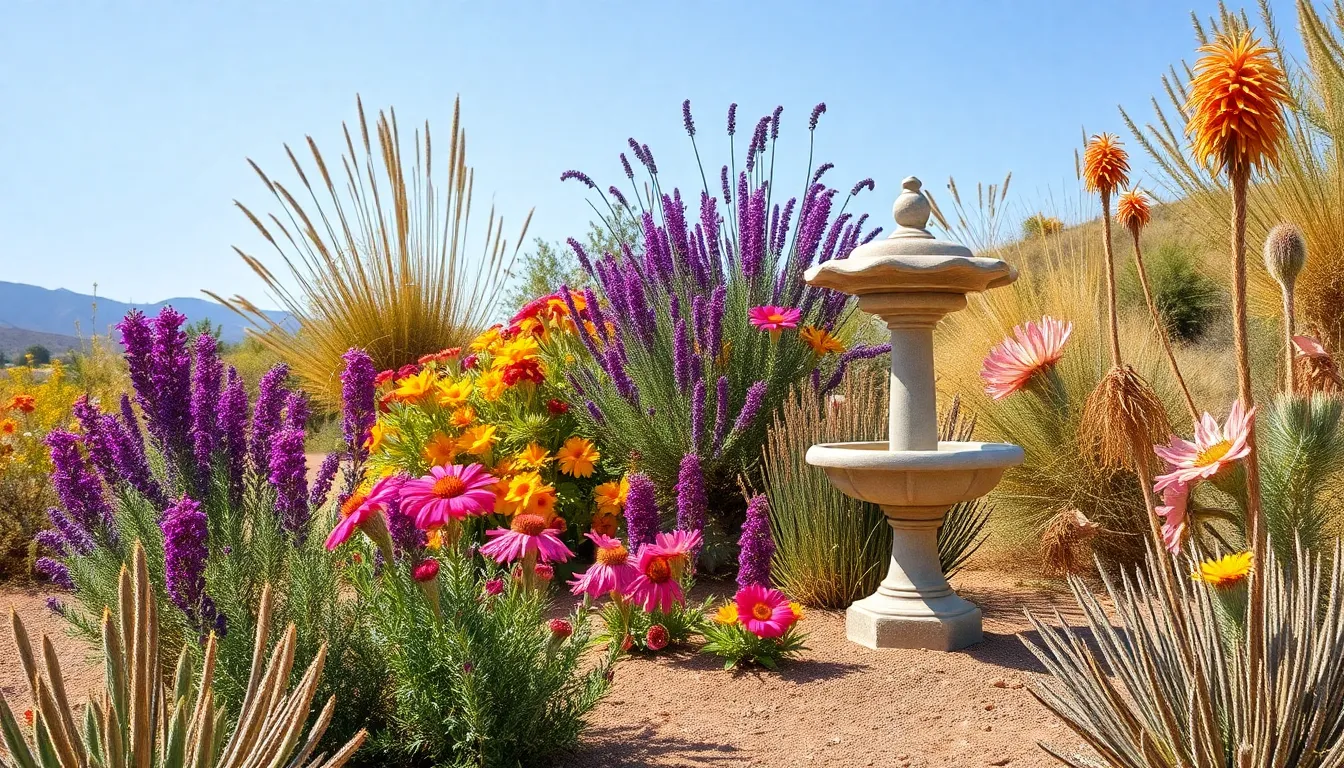
Native plants form the backbone of successful dry gardens because they’ve evolved to thrive in local conditions with minimal water requirements. These indigenous species create resilient ecosystems that support wildlife while dramatically reducing maintenance demands.
Research Indigenous Plants for Your Climate Zone
We recommend starting with comprehensive research to identify plants that naturally flourish in your exact region. Salvia species excel in dry shade areas under oak trees, making them perfect choices for challenging spots in your garden. Tools like Calscape provide detailed databases where you can explore native options suited to your exact climate zone and soil conditions.
Local nurseries specializing in native plants offer invaluable expertise about which species perform best in your area. University extension services also maintain plant databases with exact recommendations for drought-resistant natives that support local ecosystems.
Group Plants with Similar Water Requirements
Smart plant grouping creates efficient watering zones that minimize water waste and maximize plant health. We organize drought-tolerant species together in dedicated areas where they can share similar irrigation schedules and soil conditions. This hydrozoning approach prevents overwatering sensitive plants while ensuring each species receives appropriate moisture levels.
Plants with identical water needs also develop complementary root systems that improve soil structure and prevent erosion. Manzanita and Deer Grass work beautifully together, creating stunning visual combinations while sharing similar water requirements throughout the growing season.
Support Local Wildlife with Native Flowering Species
Native flowering plants like Clarkia and Phacelia attract essential pollinators while creating vibrant seasonal displays in dry garden spaces. We select species that bloom at different times to extend foraging opportunities for bees, butterflies, and hummingbirds throughout the year.
Toyon provides dual benefits by offering wildlife cover and producing berries that feed birds during autumn months. These native flowering species create interconnected food webs that support biodiversity while requiring minimal irrigation once established. Bird baths positioned near flowering plants enhance wildlife habitat while adding focal points to your native plant communities.
Install Hardscaping Elements for Structure
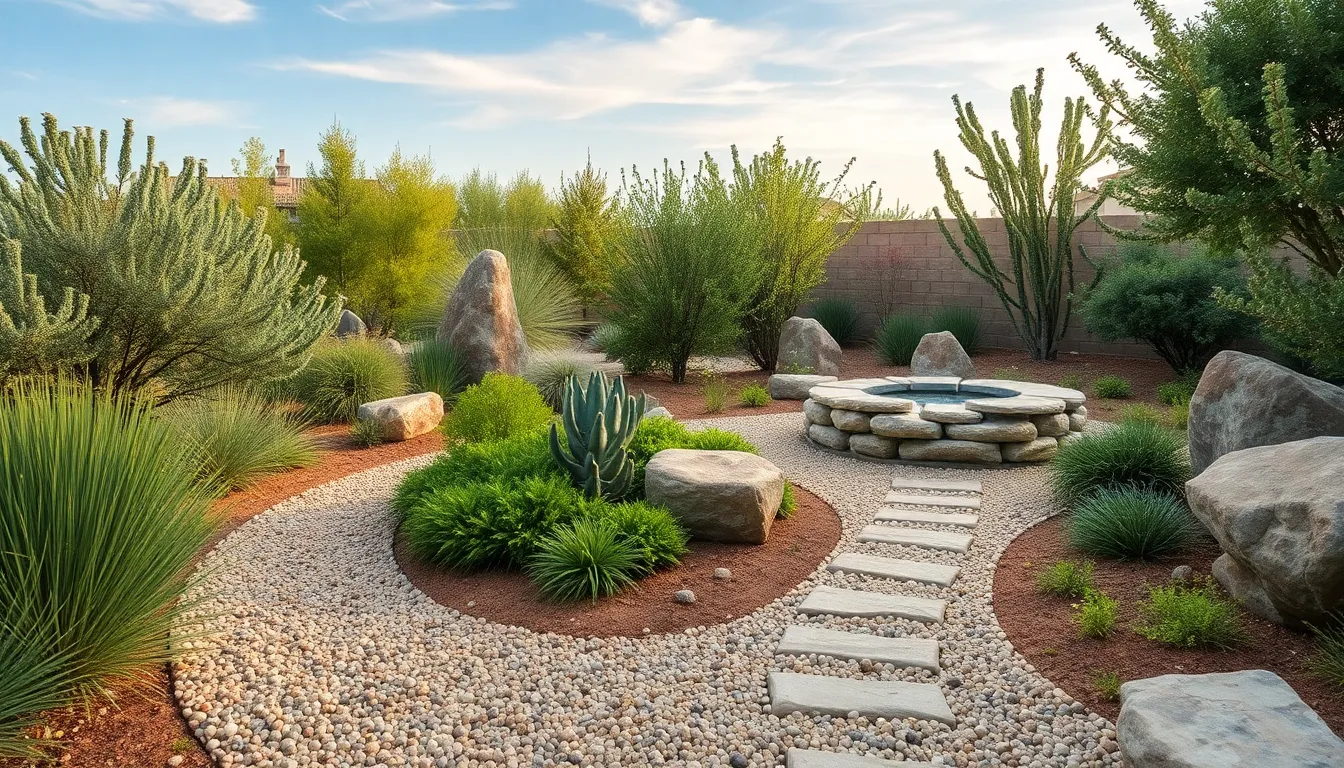
Hardscaping elements transform dry gardens from simple plant collections into sophisticated outdoor spaces with lasting visual impact. These permanent features provide the structural foundation that makes drought-tolerant landscaping both functional and beautiful.
Add Pathways Using Permeable Materials
Permeable pathways serve as the backbone of well-designed dry gardens while supporting water conservation efforts. Gravel walkways allow rainwater to penetrate directly into the soil, reducing surface runoff and naturally irrigating nearby drought-resistant plants. Porous pavers create more formal pathway options that still maintain excellent drainage properties.
Installing these water-friendly materials prevents erosion around your Mediterranean-style plantings while eliminating the need for constant weeding. We recommend using decomposed granite or crushed stone for informal garden areas, as these materials complement the natural textures of succulents and ornamental grasses. Stepping stone paths work exceptionally well when combined with groundcover sedums, creating a cohesive design that requires minimal maintenance.
Create Focal Points with Decorative Boulders
Decorative boulders anchor dry garden designs and create dramatic visual statements that draw the eye through your industry. Large stones positioned strategically throughout planting areas establish natural gathering points and frame your drought-tolerant plant collections effectively. Boulder placement near seating areas or at pathway intersections creates a sense of permanence that complements the organic shapes of agave and barrel cacti.
Selecting locally sourced stone ensures your boulders blend seamlessly with existing rock garden features while supporting regional aesthetics. We suggest grouping odd numbers of stones in varying sizes to create the most natural appearance. Weathered granite or sandstone boulders work particularly well with native plant communities, providing wildlife habitat while improving the rustic ambiance of your dry garden space.
Design Seating Areas with Natural Stone
Natural stone seating areas integrate beautifully with drought-resistant landscapes while providing comfortable spaces to enjoy your garden’s seasonal changes. Stone benches positioned among aromatic herbs like rosemary and lavender create inviting rest spots that require zero irrigation. Flagstone patios surrounded by ornamental grasses offer larger entertaining spaces that complement the Mediterranean garden aesthetic.
Building stone seating elements using materials that match your existing hardscaping creates visual continuity throughout the garden design. We recommend incorporating built-in planters around seating areas to showcase colorful sedums and architectural succulents at eye level. These stone features retain heat during cooler months, extending the usable season of your outdoor living spaces while supporting the warm microclimate that many drought-tolerant plants prefer.
Implement Smart Irrigation Solutions
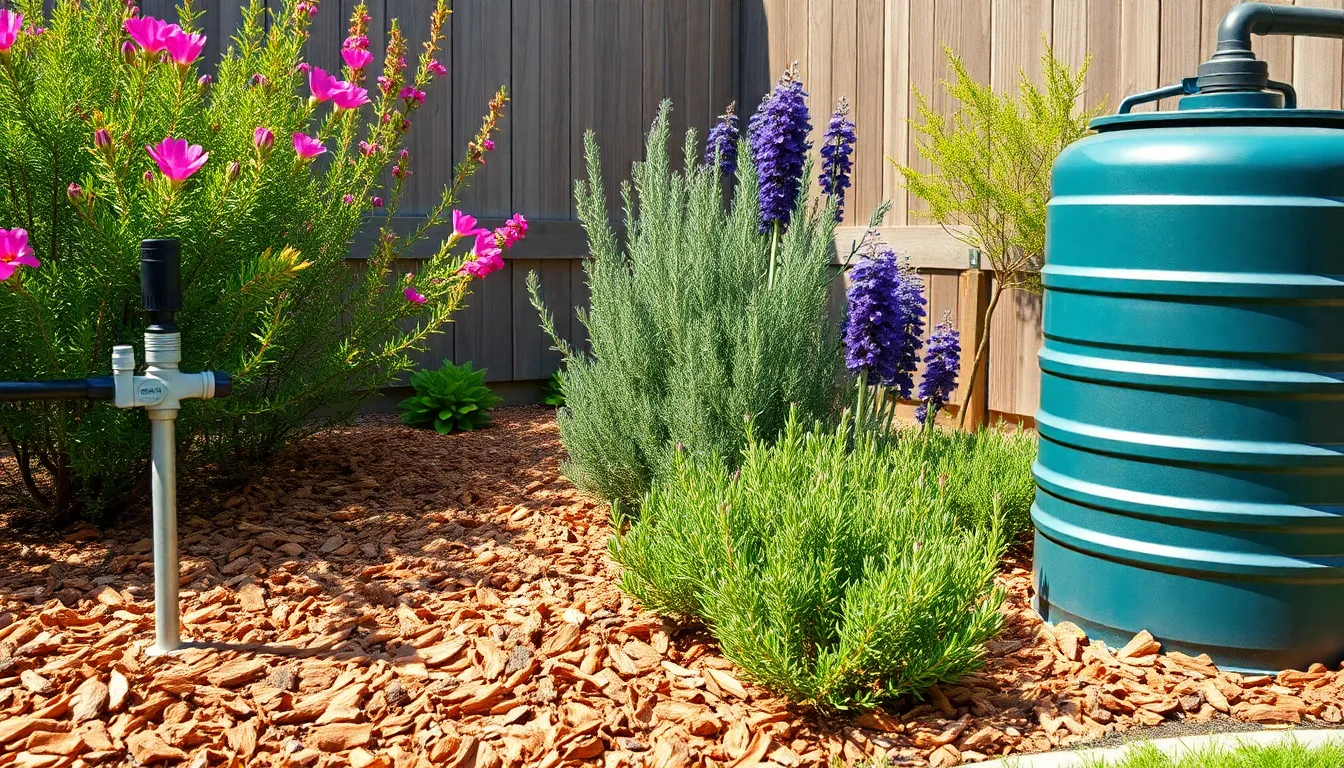
Smart irrigation transforms how we approach water management in our dry gardens. Advanced watering systems deliver precise moisture exactly where plants need it most.
Install Drip Irrigation for Efficient Water Use
Drip irrigation delivers water directly to plant roots, reducing water usage by up to 60% compared to traditional sprinklers. We can install soaker hoses around our plants to provide slow, steady moisture exactly where needed. These systems minimize evaporation and runoff, ensuring every drop reaches the plants rather than being wasted on surrounding soil.
Regular maintenance of drip irrigation systems prevents leaks and maintains optimal efficiency. We should check emitters monthly to ensure proper water flow and replace any damaged components immediately. Setting automated timers allows us to water during early morning hours when evaporation rates are lowest, maximizing water absorption.
Use Mulching Techniques to Conserve Moisture
Organic mulch like wood chips or bark retains soil moisture and suppresses weeds, reducing our need for frequent watering. We can apply a 2-3 inch layer around plants, keeping mulch away from plant stems to prevent rot. This natural barrier creates a protective layer that slows water evaporation from the soil surface.
Inorganic mulch options like gravel or decomposed granite improve drainage while preventing waterlogging. These materials work particularly well in our Mediterranean herb gardens and rock garden features. Gravel mulch suppresses weeds effectively while allowing air circulation around plant roots, supporting the health of drought resistant plants like thyme and rosemary.
Consider Rainwater Harvesting Systems
Rainwater harvesting systems provide a important water source for irrigation, reducing our reliance on municipal supplies during dry periods. We can install rain barrels connected to our downspouts to capture and store water from roof runoff. These systems prove especially beneficial when combined with our drip irrigation networks.
Implementing larger cistern systems allows us to collect substantial water volumes for extended dry seasons. We should position collection tanks strategically throughout our garden to distribute water efficiently to different plant zones. This approach complements our native plant communities and succulent collections, providing supplemental moisture when natural rainfall becomes scarce.
Plan for Seasonal Color and Interest
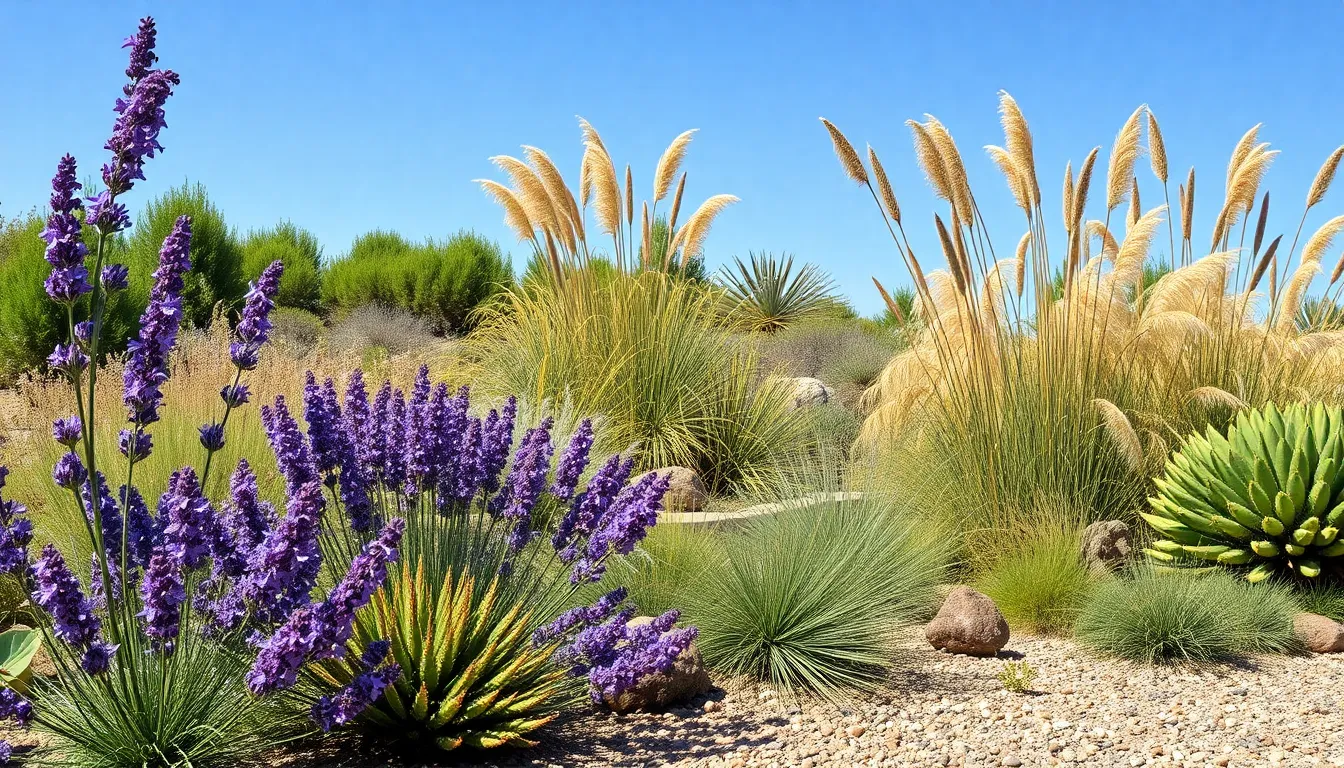
Creating year-round visual appeal in our dry gardens requires strategic plant selection that provides continuous color and texture throughout all seasons.
Select Plants with Varying Bloom Times
Choosing plants with staggered flowering periods ensures our dry gardens maintain vibrant color from spring through fall. Lavandula angustifolia ‘Hidcote’ provides early spring blooms with its compact purple flower spikes, while Calamagrostis x acutiflora ‘Karl Foerster’ delivers stunning summer color with its feathery golden plumes.
Mediterranean plants naturally extend our blooming season since they’ve evolved to flower during different periods in harsh climates. Teucrium fruticans offers silvery foliage and delicate blue flowers in early summer, creating a beautiful contrast when paired with the architectural form of Stipa gigantea, which produces dramatic seed heads later in the season.
Planning our plant combinations around these varied bloom times creates waves of color that carry us from one season to the next without gaps in visual interest.
Incorporate Evergreen Elements for Winter Structure
Evergreen shrubs form the backbone of our dry gardens during winter months when deciduous plants go dormant. Lavandula angustifolia serves dual purposes as both a seasonal bloomer and year-round structural element, maintaining its silvery foliage throughout winter while requiring minimal water.
Gravel mulch around these evergreen elements enhances their winter presence while serving practical purposes. This approach retains soil moisture during dry periods and creates clean lines that highlight the plants’ natural forms against the neutral backdrop.
Strategic placement of evergreen plants creates focal points that anchor our garden design when other elements are dormant, ensuring our outdoor spaces remain visually appealing throughout the coldest months.
Choose Plants with Interesting Seed Heads and Bark
Ornamental grasses like Calamagrostis x acutiflora ‘Karl Foerster’ provide exceptional winter interest through their striking seed heads that catch frost and create dramatic silhouettes. These persistent structures add movement and texture to our gardens even after the growing season ends.
Drought tolerant trees with attractive bark patterns create year-round focal points that become more prominent during winter months. Oak and olive species offer unique bark textures that provide visual interest when combined with the structural elements of ornamental grasses.
Allowing these seed heads to remain through winter rather than cutting them back extends the garden’s seasonal appeal while providing food sources for birds and beneficial insects that support our garden’s network.
Conclusion
Creating a stunning dry garden doesn’t require sacrificing beauty for water conservation. We’ve shown you how combining drought-resistant succulents ornamental grasses Mediterranean herbs and thoughtful stone features creates an outdoor space that’s both visually striking and environmentally responsible.
The key to success lies in choosing the right plants for your climate zone and implementing smart irrigation systems that deliver water precisely where it’s needed. By grouping plants with similar water requirements and incorporating native species you’ll build a garden that thrives with minimal maintenance.
Your new dry garden will reward you with year-round interest reduced water bills and more time to enjoy your outdoor space rather than constantly maintaining it. Start with one section and gradually expand your drought-resistant paradise.
Frequently Asked Questions
What is dry gardening and why is it beneficial?
Dry gardening is a landscaping approach using drought-resistant plants that require minimal water. It’s beneficial because it significantly reduces water bills, especially during summer months, requires less maintenance time, and creates visually appealing outdoor spaces that thrive in challenging conditions without excessive effort or expense.
Which succulents work best for dry gardens?
The best succulents for dry gardens include Echeveria, jade plants, hens and chicks, and barrel cacti for their unique shapes and minimal water needs. Architectural plants like agave and aloe serve as dramatic focal points, while colorful sedums like Autumn Joy and Dragon’s Blood provide vibrant year-round displays.
How do ornamental grasses enhance dry garden designs?
Ornamental grasses add texture, movement, and seasonal interest while being highly water-efficient. Native varieties like blue grama and feather reed grass adapt well to local conditions, require minimal maintenance, and support biodiversity. Layering grasses of varying heights creates dynamic spaces with structural variety.
What herbs work well in Mediterranean-inspired dry gardens?
Mediterranean herbs perfect for dry gardens include rosemary and lavender, which thrive in hot, dry conditions and provide fragrance and pollinator attraction. Culinary herbs like basil and thyme are drought-tolerant and enhance cooking. Plant these in raised beds with proper drainage using terracotta pots and limestone for authentic Mediterranean aesthetics.
How can rock gardens and stone features improve dry landscapes?
Rock gardens transform flat landscapes into captivating spaces requiring minimal water. Use natural stone from local quarries to create authentic designs that blend with existing elements. Varied stone types add depth, larger stones serve as focal points, and rocky slopes create elevation changes while improving natural drainage.
Why are native plants important in dry gardening?
Native plants are crucial because they naturally thrive in local conditions with minimal water requirements and support local wildlife. They require less maintenance, attract beneficial pollinators, and create sustainable ecosystems. Research indigenous species through local nurseries and university extension services for best results.
What hardscaping elements work best in dry gardens?
Effective hardscaping includes permeable pathways using gravel and porous pavers to support water conservation and reduce erosion. Decorative boulders serve as focal points, while natural stone seating areas provide comfortable garden spots. These elements integrate seamlessly with drought-resistant landscapes, creating cohesive, functional outdoor spaces.
How can smart irrigation systems help dry gardens?
Smart irrigation systems, particularly drip irrigation, deliver precise moisture while reducing water usage by up to 60% compared to traditional methods. These systems require regular maintenance for optimal performance. Combine with rainwater harvesting systems to further reduce reliance on municipal water supplies.
How do you maintain year-round interest in dry gardens?
Plan for seasonal color by selecting plants with varying bloom times from spring through fall. Incorporate evergreen elements for winter structure, ornamental grasses for texture, and drought-tolerant trees with interesting seed heads and bark. This creates continuous visual appeal and supports wildlife throughout all seasons.
What mulching techniques work best for water conservation?
Use both organic mulches (like wood chips) and inorganic options (like gravel) to conserve moisture and suppress weeds. Gravel mulch works particularly well around drought-resistant plants like thyme and rosemary, enhancing plant health while creating visual cohesion and minimizing maintenance requirements.

